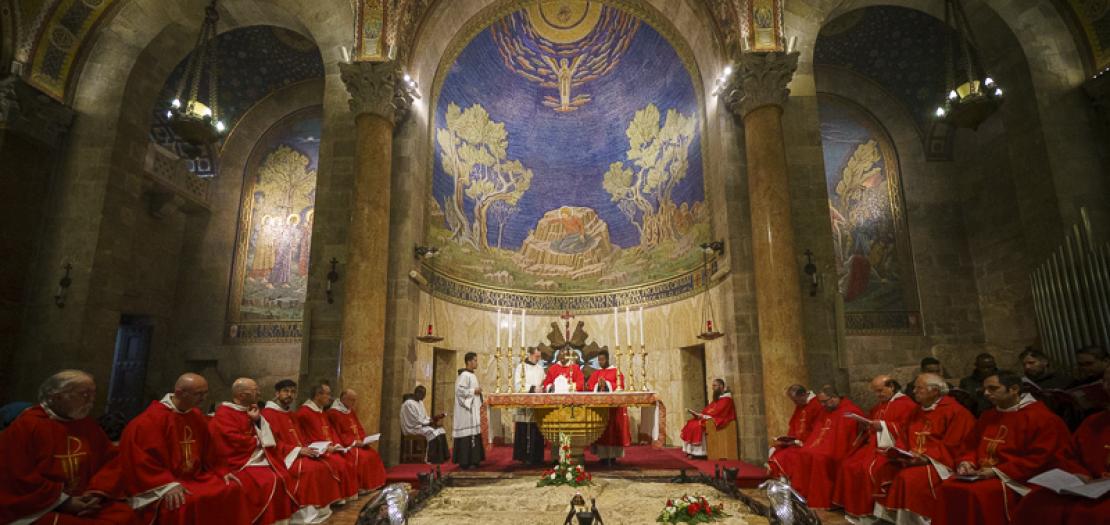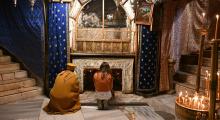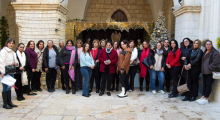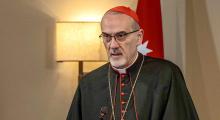Issued by the Catholic Center for Studies and Media - Jordan. Editor-in-chief Fr. Rif'at Bader - موقع أبونا abouna.org

On Wednesday, March 15, the second peregrination of Lent took place at the Basilica of Gethsemane - called “of the Agony” – at the foot of the Mount of Olives in Jerusalem. It is here that the agony and the prayer of the Lord in preparation for his Passion is remembered: this event shows all the humanity of Christ who, according to the evangelist Matthew, “began to feel sad and anxious” to the point of sweating blood.
The present-day Basilica (which was built on an axis placed at the meeting point between the perimeter of the Byzantine church and the Crusader one) was designed by the architect Antonio Barluzzi and has inside it an isolated block of rock where the memory of Jesus’s suffering is concentrated. It is also called the “Church of the Nations” because very many countries contributed to its building and the coats-of-arms of the nations are represented in the domes and in the mosaics in the apse. To better give the impression of sorrow and dejection, the interior is left in semi-darkness, thanks to the shades of violet of the alabaster of the windows and the dark blue of the vault. Between the Grotto of Betrayal and the Rock of Gethsemane, there is a grove of olive trees, some of which - enclosed at the entry to the Sanctuary – come from an ancient strain, probably contemporary with Jesus.
The celebration of the Eucharist was presided by Fr. Piermarco Luciano, vicar of the fraternity of St. Saviour in Jerusalem and deputy master of the theological students’ hall of residence. The homily was again delivered by Father fr. Alessandro Coniglio, a lecturer at the Studium Biblicum Franciscanum in Jerusalem, chosen to guide the Franciscans through the period of Lent with his reflections on the Scriptures. Father Coniglio – who in his last homily had started to reflect on the mystery of God and his involvement in the grief of human affairs - continued to meditate on the mystery of the suffering that God feels in coming to the help of man, the sinner.
During his comment on the readings, he dwelled on the figure of the “servant of the Lord” announced by the prophet Isaiah (cf. 52,13), summoned by God for a particular mission: this servant is the man Jesus “who seems to come deliberately to carry out this waiting: he, the innocent one, “ says fr. Alessandro Coniglio, “ feels sadness and anguish, a mortal sadness and the cup of sorrow is something so terribly bitter, that Jesus prays insistently to his Father to spare him from it. But Jesus knows his mission; he knows that, although he is the Son of God, he will have to learn how to be a servant, he will have to do what Isaiah had predicted, he will have to suffer and endure, not for his sins but for those of every human being. The Son of God becomes a servant so that servants can go back to being sons again.” In a vivid image which refers back to the toponym of this place (in Aramaic Gethsemane means “olive-press”) fr. Coniglio emphasizes that “the Father begins there to squeeze his Son in the press of Gethsemane: Jesus will have to let himself be crushed by the weight of the sins of the world, so that the sin, crushed by this grindstone of pain, can let the juice of salvation and divine pity flow.
In front of the naked rock where Jesus sweated blood, Fr. Alessandro exhorts us to “see behind the sufferings that we live every day, God’s design of love for us and for humanity, because these sufferings, which have already been taken on by the Son of God in this place, acquire a new meaning only in Him. Here, in this place, we can learn how to abandon ourselves totally into the hands of the Father even in suffering, which is salvific.”
Lastly, before the blessing, the Guardian of the Basilica of Gethsemane, Fr. Sinisa Srebenovic invited the assembly to pray for fr. Vittorio Bosello, who celebrates his 40 years of mission in the Holy Land, and then concluded recalling that the Basilica of the Nations is soon to celebrate the Centenary of its foundation in 1924.
 Amid 'fragile’ ceasefire, Caritas Jerusalem seeks to 'replant hope' in Gaza this Christmas
Amid 'fragile’ ceasefire, Caritas Jerusalem seeks to 'replant hope' in Gaza this Christmas  Jordan: Union of Religious Congregations holds meeting to meditate the mystery of Incarnation
Jordan: Union of Religious Congregations holds meeting to meditate the mystery of Incarnation 




